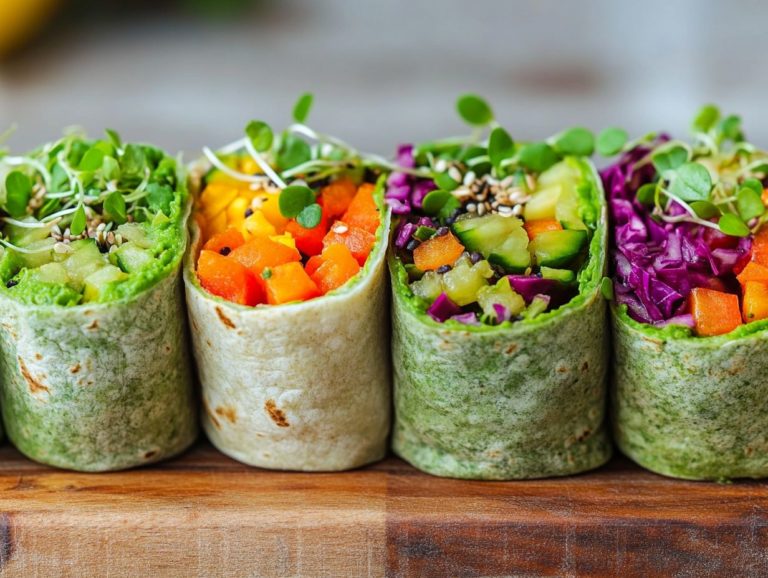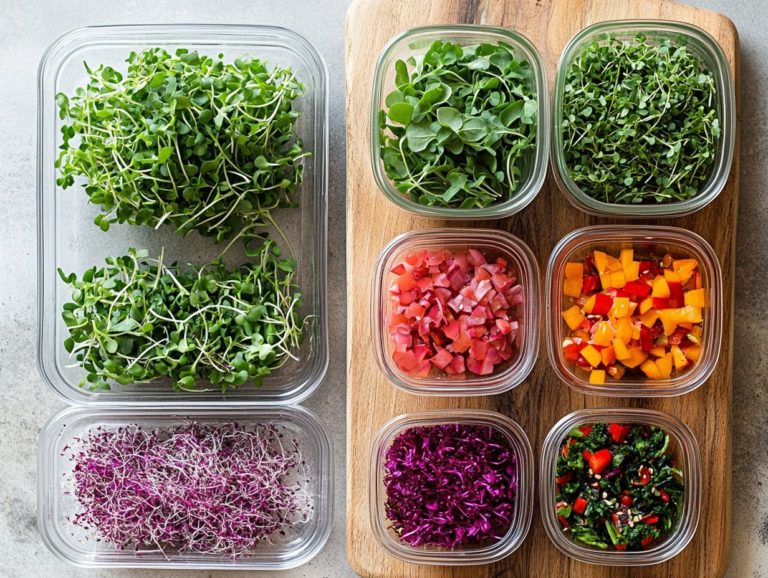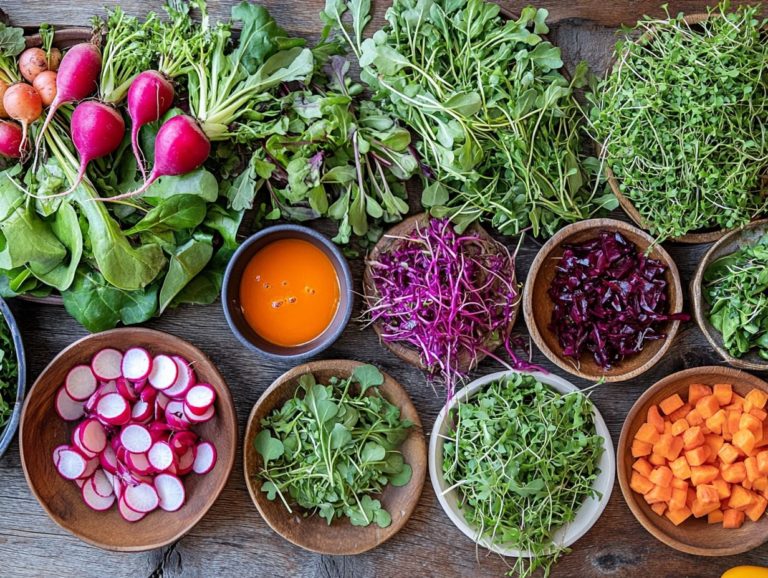69. 5 Popular Microgreen Varieties for Cooking
Microgreens have surged in popularity in the cooking world, bringing vibrant flavors, striking visuals, and profound nutritional benefits to your dishes.
Dive into the exciting world of microgreens! You ll discover five standout varieties broccoli, radish, sunflower, pea, and mustard that can elevate any meal to new heights. With popular varieties like arugula, radish, basil, and pea shoots at your disposal, microgreens offer an exciting range of flavors.
You ll explore what microgreens are, how to utilize them in cooking, and the best ways to incorporate them into your culinary creations. You ll also learn how to grow your own microgreens at home and uncover their unique flavor profiles.
Embrace this journey and unlock the green potential of your kitchen!
Contents
Key Takeaways:
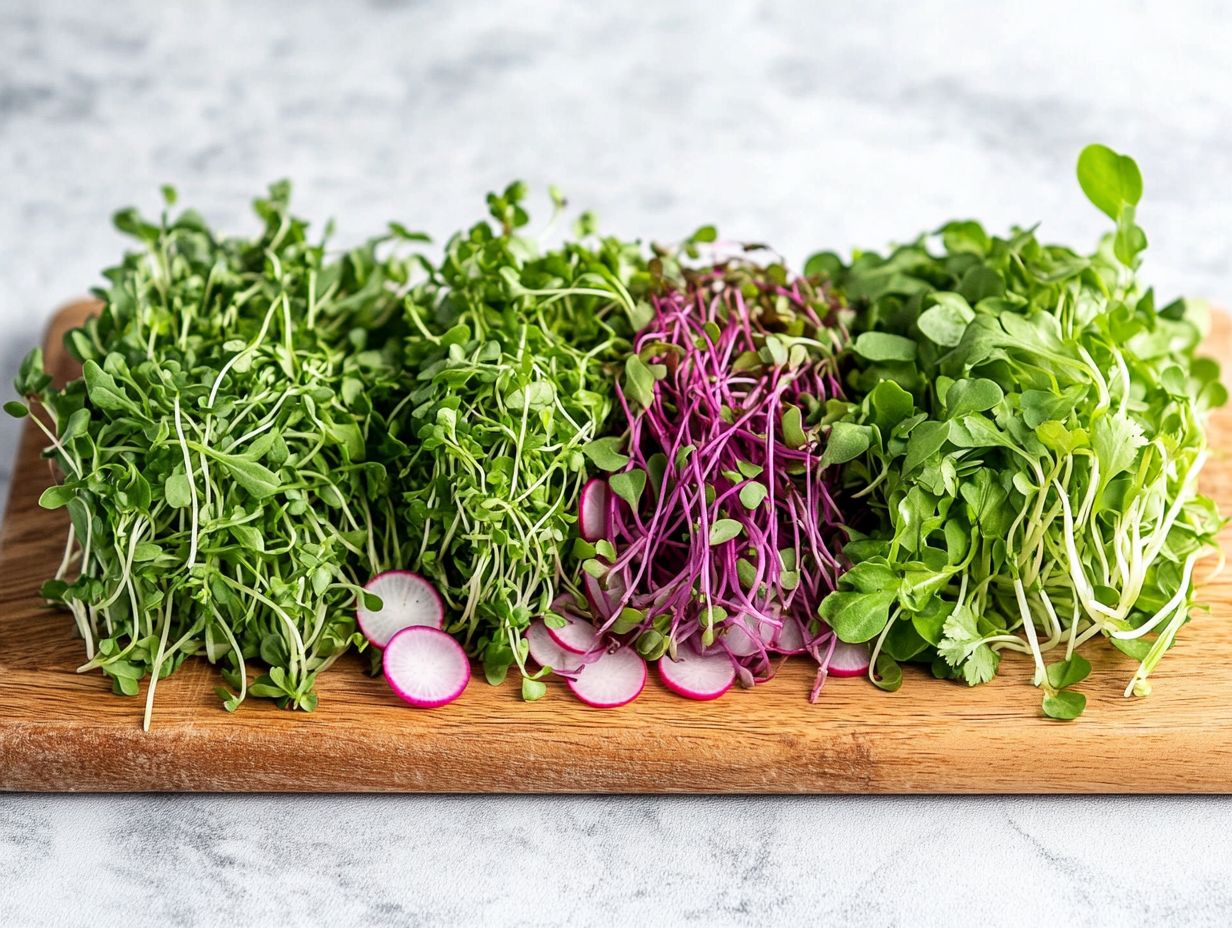
- Broccoli, radish, sunflower, pea, and mustard are popular microgreen varieties for cooking.
- Microgreens add flavor, texture, and nutrients to dishes, making them a favorite among chefs and home cooks.
- Microgreens can be easily grown at home and are widely available at farmers’ markets, specialty stores, and online.
- Don t miss out on the health benefits these tiny greens can bring to your meals!
1. Broccoli Microgreens
Broccoli microgreens have become a vibrant and nutrient-rich enhancement for your meals, gaining traction among both chefs and home cooks. With remarkable health benefits and cooking flexibility, these tiny greens are a powerhouse of flavor and nutrition.
Packed with essential nutrients like magnesium, iron, and zinc, broccoli microgreens align with health food trends and improve your dishes with distinctive flavors.
Their impressive substances that help fight inflammation support immune function, making broccoli microgreens an outstanding ally in promoting your overall wellness. Incorporating them into your daily meals is effortless; simply toss them into salads, sandwiches, or omelets to let their peppery taste shine through.
For a creative twist, consider blending them into smoothies for an extra nutrient boost or using them as a garnish for soups and seafood dishes.
In various cuisines from zesty Asian stir-fries to flavorful Mediterranean wraps these microgreens can elevate flavors and provide a delightful crunch, establishing them as an essential ingredient in your kitchen.
2. Radish Microgreens
Radish microgreens, especially the Daikon varieties, are truly a culinary gem, celebrated for their peppery taste and eye-catching appearance. They re not just a garnish; they re a go-to for chefs and food enthusiasts aiming to enhance both taste and presentation in their dishes.
These microgreens inject a vibrant burst of color into salads and sandwiches, while their unique taste profiles offer delightful variations. Take the Red Arrow variety, for example; its robust spice evokes horseradish, making it a perfect companion for tacos or grain bowls. Meanwhile, the wasabi radish microgreens deliver an unexpected kick that pairs exquisitely with seafood dishes. For a deeper dive into different options, check out the microgreen varieties: taste and flavor guide.
To truly showcase these flavors, think about incorporating them into a refreshing spring roll with shrimp or whisking them into a zesty vinaigrette to drizzle over grilled vegetables. This approach guarantees maximum flavor impact in every single bite.
3. Sunflower Microgreens
Sunflower microgreens, with their delightful nutty flavor and satisfying crunch, are becoming increasingly sought after for their remarkable health benefits. They re a premium choice for anyone looking to enhance their meals with nutritious and visually stunning ingredients.
These tiny greens are brimming with essential nutrients. They are loaded with vitamins A, C, E, and K that your body will love! Packed with minerals like calcium, iron, and magnesium, they can support stronger bones and improve metabolic function.
Incorporating sunflower microgreens into your culinary creations is a breeze. Toss them into salads for an extra crunch, use them as a garnish on soups, or blend them into smoothies for a healthy boost.
If you’re interested in growing your own, consider using hydroponic systems, which involves growing plants without soil, using nutrient-rich water instead, or potting soil method for optimal results. This approach can yield vibrant, fresh microgreens right in your kitchen, making it an accessible and rewarding experience for anyone committed to a healthy lifestyle.
4. Pea Microgreens

Pea microgreens, especially the delightful pea shoots, are a true culinary treasure. Their sweet taste and tender texture make them a versatile ingredient that elevates a variety of dishes while offering a wealth of health benefits.
These tiny greens are packed with essential vitamins like A, C, and K, transforming them from mere garnish into a rich source of health-boosting nutrients and good for digestion. To maximize their benefits, explore seasonal microgreen varieties for year-round growth. Their vibrant green hue and delicate sweetness beautifully complement an array of cuisines, from crisp salads to gourmet entrees.
For a refreshing twist, consider tossing them into a citrusy salad with creamy avocado and tangy feta, or blending them into a unique pesto to elevate your pasta dish. The subtle flavor of pea microgreens can also add depth to stir-fries or serve as an elegant garnish for soups, showcasing their remarkable versatility and nutritional prowess. To explore different options, check out this quick guide to common microgreen varieties.
5. Mustard Microgreens
Mustard microgreens are a vibrant addition to the microgreens family, celebrated for their spicy flavor and impressive health benefits. If you’re looking to elevate your dishes with a distinctive kick, these tiny greens are a fantastic choice.
You ll find they come in various types, each offering a unique tasting experience from the fiery heat of black mustard to the milder, nutty notes of yellow mustard. They are loaded with vitamins A, C, and K, along with powerful antioxidants, delivering a nutritional punch that promotes overall health.
Don’t miss out on sprinkling them on sandwiches for an instant flavor boost! Toss them into vibrant salads, or blend them into pestos and dressings for a delightful twist. Their versatility invites you to experiment across different cuisines, transforming each dish into something not only more delicious but also more nutritious.
What Are Microgreens and Why Are They Popular for Cooking?
Microgreens are those young, edible plants you ll want to harvest just after the first true leaves make their debut. Celebrated for their vibrant colors, intense flavors, and impressive nutrients, they ve become the darlings of chefs and home cooks alike, not to mention a staple in health food stores.
These nutrient-packed greens don’t just elevate the visual appeal of your dishes; they also bring an array of health benefits, making them a must-have ingredient in modern cuisine. If you’re looking to enhance your culinary skills, learning how to grow your favorite microgreen varieties is essential. Their versatility means you can incorporate them into an endless variety of recipes, from salads to garnishes, catering to all sorts of culinary preferences.
With popular varieties like arugula, radish, basil, and pea shoots at your disposal, microgreens offer an exciting range of flavors that can truly enhance any dish. For those new to growing them, check out microgreen varieties: a guide for beginners. Cultivated mainly for their tender texture and rich nutritional content, they often boast higher levels of vitamins and antioxidants compared to their fully grown counterparts.
This remarkable nutritional profile resonates with today s health-conscious consumers, who are increasingly seeking food that not only delights the palate but also supports overall well-being. As the trend towards fresh food from local farms continues to flourish, these tiny greens are making their way into a multitude of contemporary dishes, reinforcing the beautiful connection between healthy eating and culinary creativity.
How Can Microgreens Be Used in Cooking?
Microgreens can take your cooking to the next level! They serve a multitude of purposes from vibrant salads and hearty sandwiches to rich soups and invigorating smoothies. They not only add flavor but also boost the nutritional profile of your dishes.
These tiny greens pack a punch with their intense flavors, elevating even the simplest meals to gourmet heights. Imagine enhancing a colorful salad with a sprinkle of radish or sunflower microgreens, introducing a delightful crunch and a peppery kick. Alternatively, consider blending them into your smoothies for an added health boost. Mixing pea shoots or kale microgreens with your favorite fruits can create a refreshing morning treat. For more information on selecting the best options for your garden, check out our guide on how to choose microgreen varieties.
In terms of soups, a garnish of cilantro microgreens adds freshness and improves the presentation. For your dinner parties, don’t shy away from using microgreens as elegant garnishes for appetizers like bruschetta or smoked salmon. To elevate your dishes even further, consider trying must-try microgreen varieties for salads. This small touch showcases your creativity and flair, leaving your guests truly impressed.
What Are the Nutritional Benefits of Microgreens?

Microgreens are nutrient powerhouses, often packing higher concentrations of vitamins, minerals, and antioxidants than their mature counterparts, making them an invaluable addition to your healthy diet.
These petite greens, including varieties like radish, broccoli, and spinach, are celebrated for their impressive health benefits. In fact, a study published in the Journal of Agricultural and Food Chemistry revealed that some microgreens, such as the top 5 microgreens for smoothies, can contain up to 40 times the nutrient density of fully grown versions, especially in vitamins C, E, and K.
The vital antioxidants found in these microgreens work to combat oxidative stress, potentially lowering your risk of chronic diseases. Don t miss out on these nutrient-packed greens that can supercharge your health! By incorporating these tiny, flavorful greens into your meals, you not only enhance the taste but also make a significant contribution to your overall health and well-being.
Where Can One Find Microgreens for Cooking?
You can source microgreens from various places, including health food stores, farmers markets, and online retailers like True Leaf Market and Amazon. This caters to your diverse preferences.
With the increasing popularity of these healthy greens, you’re likely to find them at local co-ops and specialty grocery stores. When selecting where to purchase, it s crucial to seek out bright greens that are crisp and free from wilting or discoloration.
By opting for local suppliers, you not only support your community but also ensure fresher, seasonal varieties that aren t mass-produced. These flavorful additions can elevate both nutrition and taste while promoting sustainable agricultural practices, making them an outstanding choice for health enthusiasts and environmentally conscious consumers.
How Can One Grow Microgreens at Home?
Growing microgreens at home is fun and rewarding! You can easily cultivate fresh greens right in your kitchen, whether you choose hydroponics, which is growing plants in water without soil, or the tried-and-true potting soil method, which is soil designed for planting in pots.
With just a few easy steps, transform your space into an indoor oasis filled with vibrant flavors and essential nutrients. Start by selecting your favorite microgreen varieties, such as arugula, kale, or radish; for more guidance, check out choosing the right microgreen seeds, as these are known for their quick germination and ease of growth.
If you opt for hydroponics, gather materials like a shallow tray, nutrient-rich water, and a grow light to mimic sunlight. If you prefer potting soil, make sure it s of high quality and well-draining to ensure optimal growth conditions.
Once you ve sown the seeds, maintaining consistent moisture and optimal light is essential for healthy growth. Keep a close eye on your greens and provide gentle care to avoid common pitfalls like overwatering or insufficient light. With a little care, you ll enjoy a plentiful harvest that will elevate your culinary creations.
What Are the Different Types of Microgreens and Their Flavor Profiles?
Imagine the world of microgreens, where each variety boasts its own unique flavor profile, capable of elevating any dish. Picture the sweet notes of pea microgreens mingling with the spicy kick of mustard microgreens, transforming your culinary creations into something extraordinary.
Then there’s the nutty flavor of sunflower microgreens, which pairs perfectly with hearty salads, while the slightly bitter and earthy taste of arugula microgreens adds depth to your pastas and pizzas. If you’re looking to infuse your meals with an aromatic touch, basil microgreens provide a fresh burst that enhances tomato-based dishes, and cilantro microgreens can brighten up your tacos and salsas. For more information on the best microgreens for nutritional value, consider exploring various options to elevate your cooking.
To truly harness their unique tastes, think about combining spicy radish microgreens with creamy spreads for a delightful contrast. This way, you can optimize your culinary adventures with the vibrant essence these tiny greens bring to the table.
Frequently Asked Questions
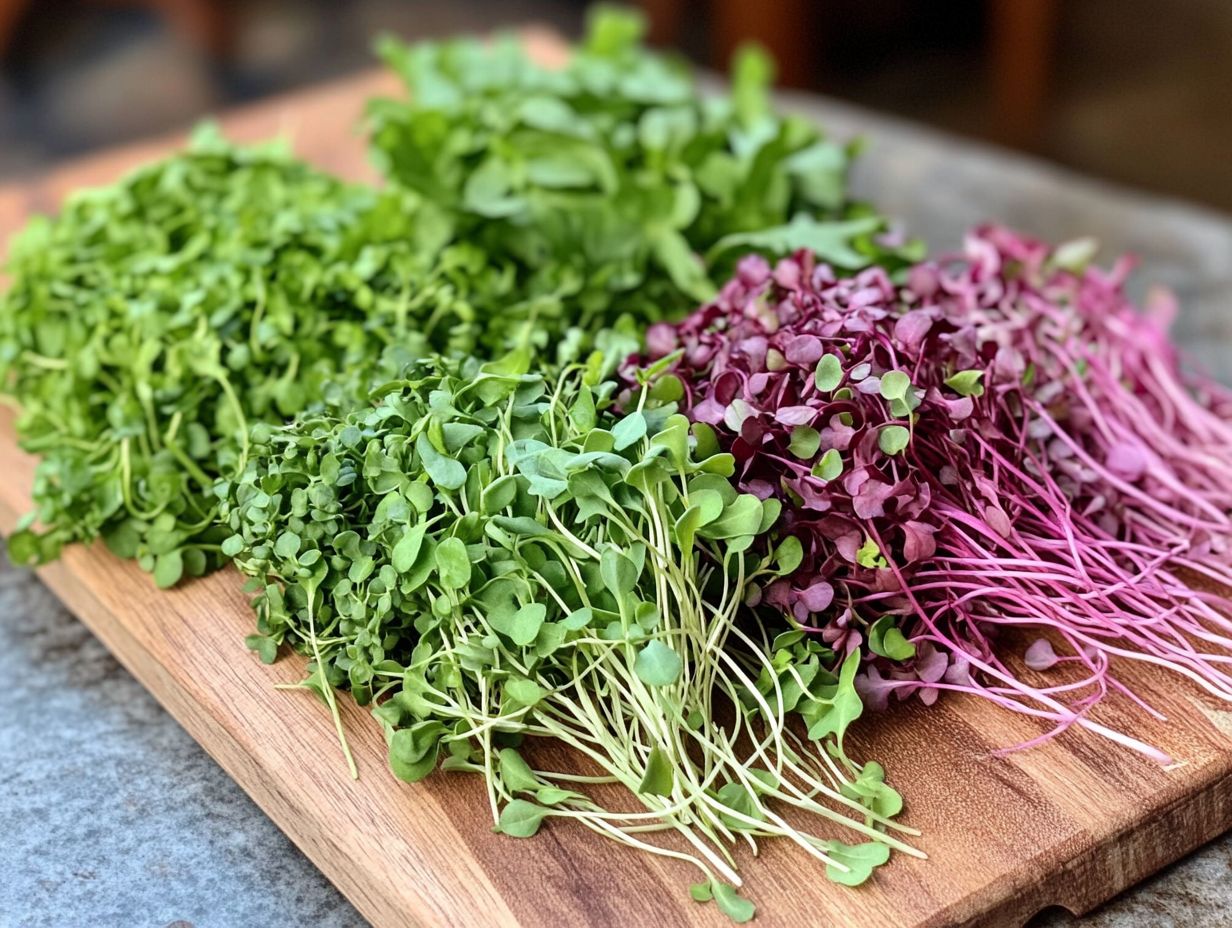
What are microgreens?
Microgreens are young vegetable greens harvested early. They are flavorful, colorful, and packed with nutrients.
Why are microgreens popular for cooking?
Microgreens are popular in cooking because they add a burst of flavor and nutrition to dishes. They are easy to grow and can be harvested within a few weeks, making them a quick and convenient ingredient for home cooks.
What are some popular microgreen varieties for cooking?
Some popular microgreen varieties for cooking include broccoli, pea shoots, radish, sunflower, and cilantro. These varieties are widely available, easy to grow, and offer unique flavors that can enhance a variety of dishes.
How do you use microgreens in cooking?
Microgreens can be used in cooking in various ways. They can top salads, sandwiches, and soups, or be incorporated into omelets, stir-fries, and smoothies. They also make great garnishes for main dishes, adding a pop of color and flavor.
Explore the world of microgreens today and add a burst of flavor to your meals!
Can you grow your own microgreens for cooking?
Yes, you can grow your own microgreens at home. Just grab a shallow container, potting mix, and some seeds.
You can grow microgreens indoors all year long. They re convenient and cost-effective for your cooking.
What are the nutritional benefits of microgreens?
Microgreens are young plants harvested just after the first leaves develop. They are highly nutritious, packed with vitamins, minerals, and antioxidants.
They also provide fiber and enhance the nutrient content of your meals. Adding microgreens makes your diet healthier and more balanced!
Start growing your own microgreens today and elevate your dishes with fresh flavors and nutrients!


